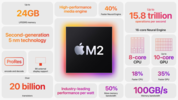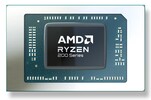Apple M2 vs AMD Ryzen 9 H 270 vs AMD Ryzen 7 260
Apple M2
► remove from comparison
The Apple M2 is a System on a Chip (SoC) from Apple that is found in the late 2022 MacBook Air and, MacBook Pro 13. It offers 8 cores divided in four performance cores and four power-efficiency cores. The big cores offer 192 KB instruction cache, 128 KB data cache, and 16 MB shared L2 cache (up from 12 MB). The four efficiency cores are a lot smaller and offer only 128 KB instruction cache, 64 KB data cache, and 4 MB shared cache. The efficiency cores (E cluster) clock with up to 2,4 GHz, the performance cores (P cluster) with up to 3,5 GHz and therefore higher than the M1 cores. The architecture should be similar to the A15 (iPhone 13) with Avalanche and Blizzard cores.
The chip features a unified memory architecture for the CPU and GPU cores and supports up to 24 GB LPDDR5-6400 for a bandwidth of up to 100GB/s.
According to Apple, the M2 offers a 18% higher CPU performance at the same power consumption level compared to the Apple M1. In our tests, the MacBook Pro 13 with active cooling was able to reach the 18% in Geekbench Multi. In other benchmarks we measured 12 to 15% gains compared to the M1. Therefore, the performance is now near the M1 Pro with 8 cores. The passively cooled MacBook Air may however suffer from throttling in longer load scenarios.
The integrated graphics card in the M2 offers 8 or 10 cores and a peak performance of 3.6 TFLOPs.
Furthermore, the SoC integrates a fast 16 core neural engine with a peak performance of 16 TOPS (for AI hardware acceleration), a secure enclave (e.g., for encryption), Thunderbolt / USB 4 controller, an ISP, and media de- and encoders.
The Apple M2 includes 20 billion transistors (up from the 16 billion of the M1) and is manufactured in the second generation 5nm process at TSMC (most likely N5P). The power consumption is rated at 20W what we also measured under CPU load.
AMD Ryzen 9 H 270
► remove from comparison
The Ryzen 9 H 270 is a rebadged Ryzen 9 270 (or Ryzen 9 8945HS) for China, making it a fast mobile laptop processor. This is an APU of the Hawk Point family that has eight Zen 4 cores running at 4.0 GHz to 5.2 GHz. This APU was introduced at CES 2025 and all of its cores are SMT-enabled for a total of 16 processing threads.
Architecture and Features
Hawk Point family chips are powered by the Zen 4 architecture, much like Phoenix and Dragon Range family chips were. The 16 TOPS NPU present here isn't powerful enough for systems built around the 9 270 to be Copilot+ certified.
Elsewhere, the chip has 16 MB of L3 cache and support for super-fast DDR5-5600 and LPDDR5x-7500 RAM while also being compatible with USB 4 and thus with Thunderbolt. It comes with 20 PCIe 4 lanes, giving fast NVMe SSD up to 7.8 GB/s of throughput.
Please note that this processor is not overclockable and neither is it user-replaceable. It gets soldered to the motherboard for good instead (FP8 socket interface).
Performance
Its CPU performance is slated to be identical to the old Ryzen 9 8945HS and R9 7940HS.
Your mileage may vary depending on how high the CPU power limits are and how competent the cooling solution of your system is.
Graphics
The Radeon 780M has 12 CUs (768 shaders) purring away at up to 2,800 MHz. The Radeon will let you use up to 4 monitors with resolutions as high as SUHD 4320p and it will also HW-decode and HW-encode the most widely used video codecs (such as AV1, HEVC and AVC) without breaking a sweat. As for gaming, most 2024 games run fine at 1080p with settings set to Low on this graphics adapter.
Your mileage may vary depending on how high the CPU power limits are, how competent the cooling solution of the system is, how fast the RAM of the system is (there is no dedicated VRAM here).
Power consumption
This Ryzen 9 series chip has a long-term power limit (default TDP) of 35 W to 54 W, giving laptop makers a choice between longer battery life and higher performance. Either way, an active cooling solution is a must for a system powered by this chip.
The R9 H 270 is built with TSMC's 4 nm process for a reasonably good, as of early 2025, energy efficiency.
AMD Ryzen 7 260
► remove from comparison
The Ryzen 7 260 is a fast Hawk Point family chip for laptops that was announced at CES 2025. It features 8 Zen 4 cores (16 threads thanks to SMT support) running at up to 5.1 GHz. The chip is identical to the old Ryzen 7 8845HS and therefore also the Ryzen 7 7840HS (which did have a lower clocked NPU).
Architecture and Features
Hawk Point family chips are powered by the Zen 4 architecture, much like Phoenix and Dragon Range family chips were. The 16 TOPS NPU present here isn't powerful enough for systems built around the 260 to be Copilot+ certified.
Elsewhere, the Ryzen 7 has 16 MB of L3 cache and a seriously fast RAM controller (up to LPDDR5x-7500 and up to DDR5-5600). PCI-Express speeds are capped at 1.97 GB/s per lane which corresponds to the 4.0 spec.
Please note that the APU isn't overclockable and neither is it user-replaceable. It gets soldered to the motherboard for good instead (FP8 socket interfaces).
Performance
Since the R7 260 is an 8845HS / 7840HS in disguise, it's safe to expect it to be just slightly faster than the Core i9-13900H and also the Ryzen 9 7940HS, as far as multi-thread performance is concerned.
Your mileage may vary depending on how high the CPU power limits are and how competent the cooling solution of your system is.
Graphics
The Radeon 780M (12 CUs / 768 shaders, up to 2,700 MHz) is capable of powering 4 monitors simultaneously with resolutions as high as SUHD 4320p. It will also have little issue hardware-encoding and hardware-decoding the most widely used video codecs (such as AV1, HEVC, AVC). As far as gaming is concerned, the thing will let you play most games at 1080p as long as you are fine with low of very low settings.
Your mileage may vary depending on how high the APU power limits are, how competent the cooling solution of your system is, how fast the RAM of your system is (there is no dedicated VRAM here).
Power consumption
This Ryzen 7 series chip has a long-term power limit (default TDP) of 35 W to 54 W, giving system makers a choice between improving battery life and making the system they're designing as powerful as possible. Either way, an active cooling solution is a must for a laptop or a mini-PC built around this Ryzen.
The R7 260 is built with a 4 nm TSMC process for high, as of late 2023, energy efficiency.
| Model | Apple M2 | AMD Ryzen 9 H 270 | AMD Ryzen 7 260 | ||||||||||||||||||||||||||||||||||||||||||||||||||||||||||||||||||||||||||||||||||||||||||||||||||||||||||||||||||||||||||||||||
| Series | Apple M2 | AMD Hawk Point (Zen 4/4c) | AMD Hawk Point (Zen 4/4c) | ||||||||||||||||||||||||||||||||||||||||||||||||||||||||||||||||||||||||||||||||||||||||||||||||||||||||||||||||||||||||||||||||
| Series: Hawk Point (Zen 4/4c) Hawk Point-HS (Zen 4) |
|
|
| ||||||||||||||||||||||||||||||||||||||||||||||||||||||||||||||||||||||||||||||||||||||||||||||||||||||||||||||||||||||||||||||||
| Clock | 2424 - 3480 MHz | 4000 - 5200 MHz | 3800 - 5100 MHz | ||||||||||||||||||||||||||||||||||||||||||||||||||||||||||||||||||||||||||||||||||||||||||||||||||||||||||||||||||||||||||||||||
| L1 Cache | 2 MB | 512 KB | 512 KB | ||||||||||||||||||||||||||||||||||||||||||||||||||||||||||||||||||||||||||||||||||||||||||||||||||||||||||||||||||||||||||||||||
| L2 Cache | 20 MB | 8 MB | 8 MB | ||||||||||||||||||||||||||||||||||||||||||||||||||||||||||||||||||||||||||||||||||||||||||||||||||||||||||||||||||||||||||||||||
| L3 Cache | 8 MB | 16 MB | 16 MB | ||||||||||||||||||||||||||||||||||||||||||||||||||||||||||||||||||||||||||||||||||||||||||||||||||||||||||||||||||||||||||||||||
| Cores / Threads | 8 / 8 | 8 / 16 8 x 5.2 GHz AMD Zen 4 | 8 / 16 8 x 5.1 GHz AMD Zen 4 | ||||||||||||||||||||||||||||||||||||||||||||||||||||||||||||||||||||||||||||||||||||||||||||||||||||||||||||||||||||||||||||||||
| TDP | 20 Watt | 45 Watt | 45 Watt | ||||||||||||||||||||||||||||||||||||||||||||||||||||||||||||||||||||||||||||||||||||||||||||||||||||||||||||||||||||||||||||||||
| Transistors | 20000 Million | ||||||||||||||||||||||||||||||||||||||||||||||||||||||||||||||||||||||||||||||||||||||||||||||||||||||||||||||||||||||||||||||||||
| Technology | 5 nm | 4 nm | 4 nm | ||||||||||||||||||||||||||||||||||||||||||||||||||||||||||||||||||||||||||||||||||||||||||||||||||||||||||||||||||||||||||||||||
| Features | ARMv8 Instruction Set | DDR5-5600/LPDDR5x-7500 RAM, PCIe 4, USB 4, Ryzen AI (16 TOPS), MMX, SSE, SSE2, SSE3, SSSE3, SSE4A, SSE4.1, SSE4.2, AVX, AVX2, AVX-512, BMI2, ABM, FMA, ADX, SMEP, SMAP, SMT, CPB, AES-NI, RDRAND, RDSEED, SHA, SME | DDR5-5600/LPDDR5x-7500 RAM, PCIe 4, USB 4, Ryzen AI (16 TOPS), MMX, SSE, SSE2, SSE3, SSSE3, SSE4A, SSE4.1, SSE4.2, AVX, AVX2, AVX-512, BMI2, ABM, FMA, ADX, SMEP, SMAP, SMT, CPB, AES-NI, RDRAND, RDSEED, SHA, SME | ||||||||||||||||||||||||||||||||||||||||||||||||||||||||||||||||||||||||||||||||||||||||||||||||||||||||||||||||||||||||||||||||
| iGPU | Apple M2 10-Core GPU ( - 1398 MHz) | AMD Radeon 780M ( - 2800 MHz) | AMD Radeon 780M ( - 2700 MHz) | ||||||||||||||||||||||||||||||||||||||||||||||||||||||||||||||||||||||||||||||||||||||||||||||||||||||||||||||||||||||||||||||||
| Architecture | ARM | x86 | x86 | ||||||||||||||||||||||||||||||||||||||||||||||||||||||||||||||||||||||||||||||||||||||||||||||||||||||||||||||||||||||||||||||||
| Announced | |||||||||||||||||||||||||||||||||||||||||||||||||||||||||||||||||||||||||||||||||||||||||||||||||||||||||||||||||||||||||||||||||||
| Manufacturer | www.apple.com | www.amd.com | www.amd.com | ||||||||||||||||||||||||||||||||||||||||||||||||||||||||||||||||||||||||||||||||||||||||||||||||||||||||||||||||||||||||||||||||
| Codename | Hawk Point-HS (Zen 4) | Hawk Point-HS (Zen 4) | |||||||||||||||||||||||||||||||||||||||||||||||||||||||||||||||||||||||||||||||||||||||||||||||||||||||||||||||||||||||||||||||||
| Die Size | 178 mm2 | 178 mm2 | |||||||||||||||||||||||||||||||||||||||||||||||||||||||||||||||||||||||||||||||||||||||||||||||||||||||||||||||||||||||||||||||||
| max. Temp. | 100 °C | 100 °C | |||||||||||||||||||||||||||||||||||||||||||||||||||||||||||||||||||||||||||||||||||||||||||||||||||||||||||||||||||||||||||||||||
| Socket | FP8 | FP8 |
Benchmarks
Average Benchmarks Apple M2 → 100% n=2
Average Benchmarks AMD Ryzen 9 H 270 → 107% n=2
Average Benchmarks AMD Ryzen 7 260 → 109% n=2
* Smaller numbers mean a higher performance
1 This benchmark is not used for the average calculation













